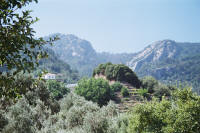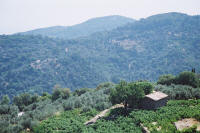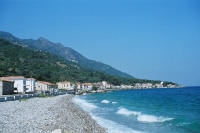Visit your favourite destinations |
| A Report from birdtours.co.uk |
Samos, The valley of the Nightingales. 17 - 31 July 2003,
All of my sightings were around a single valley, The valley of the Nightingales. I have decided to divide up my sightings according to the habitat ie from the bare mountain tops via the fields and woods to the sea.| 1.The upper crags and the bare hills. The valley rises into the mountains to the village of Manolates. Above the trees,closer to
the village, the habitat was more open with more cultivation,especially
olive groves and vines. Higher up still,the mountains are craggy,bare
and steep. |

|
Apart from flocks of higher flying SWALLOWS, RED-RUMPED
SWALLOWS and HOUSE MARTINS the main birds seen high up were raptors.
Single LONG LEGGED BUZZARDS were seen on several days ,either high above the
hill village or lower down the valley.
More exciting were a pair of SHORT TOED EAGLES seen displaying together.They
would fly at each other,extending their talons towards each other and briefly
grappling before breaking away, leaving their legs still dangling.
One evening they displayed in front of our Hotel--The Daphne--which is on a
slope facing woods and bare cliffs.
The birds frequently landed on tree tops or the tops of crags but I could not
identify any possible nest site.
At least two PEREGRINES also frequented the valley,though,as well as soaring
high up,they also flew down very low over the tree tops. On one occasion,I watched
a PEREGRINE climbing to try to harass a LONG LEGGED BUZZARD but the larger bird
did not seem too worried.
As well as the raptors, I saw up to four RAVENS at a time over the mountains.I
never saw any interaction between the birds of prey and the RAVENS but I saw
six HOODED CROWS crossing the valley in confident formation until suddenly encountering
a direct attack by a RAVEN.Without hesitation,and still in perfect formation,they
swiftly turned 180 degrees and fled back the way they had come!
2.The woods and streams. Much of the valley--which is also called Aidonia---is covered in dense,shady woodland, especially along the streams which were flowing strongly even in late July when we visited. The main tree species were Scots Pine,Plane and
Cypress with an understorey of shrubs such as bramble and honeysuckle. |
 |
I never saw-or heard-any Nightingales in the Valley
of the Nightingales,though I know that previous observers have been luckier.I
was probably too late in the season.
As well as the hirundines mentioned,I saw one or two ALPINE SWIFTS following
the valley,lower down.
HOODED CROWS and JAYS were very common in the trees and,especially , out in
the fields and orchards nearer the mouth of the valley.
One day ,I walked along one of the streams,following a juvenile YELLOW WAGTAIL
which just kept ahead of me, hopping from rock to rock. WOOD PIGEONS, COLLARED
DOVES and a few TURTLE DOVES could be encountered in clearings or along roads
and tracks.
In the tree tops were numerous GREAT TITS, CHAFFINCHES, HOUSE SPARROWS and a
few very shy ROBINS.
Once, I startled a flock of CHUKAR from the ground under a clump of pine trees
and they flew off silently but not far.Later, I found a dead one beside the
road running up the valley.
Most nights--and,curiously--once in the hot afternoon,TAWNY OWLS called to each
other from trees on both sides of the valley.
3. The sea. The sea shore at Agios Constantinos,on the north coast of Samos. |
 |
I feel obliged to include the flocks of ELEANORAS FALCONS
in the section about the sea though my first views were about a kilometer inland
.Twelve or more flew over a ridge opposite our hotel before flying down the
valley towards the sea.
Later, I saw a group of six over farmland near the village of Mili, a few kms
from the south coast. But ,later still,I counted nineteen flying directly above
the shoreline at Agios Constantinos,looking like they should ie with a background
of blue sky and rocky slopes overlooking the sea.
Most evenings,between 6 and 7pm,small groups of CORY'S SHEARWATERS flew low
over the water,generally flying east to west along the coast but,occasionally,diverting
into the bay at Agios Constantinos,before resuming their journey.
Apart from a few HERRING GULLS, they were the only birds actually seen low over
the water.
Why not send us a report, or an update to one of your current reports?